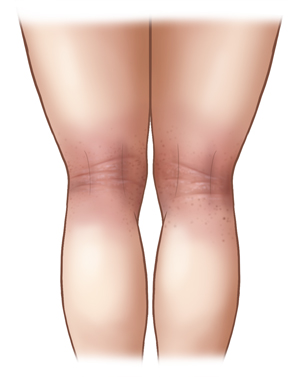A
B
C
D
E
F
G
H
I
J
K
L
M
N
O
P
Q
R
S
T
U
V
W
X
Y
Z
Topic IndexLibrary Index
Click a letter to see a list of conditions beginning with that letter.
Click 'Topic Index' to return to the index for the current topic.
Click 'Library Index' to return to the listing of all topics.
Managing Atopic Dermatitis (Eczema)
To manage your symptoms and help reduce the severity and frequency, try these self-care tips.
Caring for your skin
-
Use a gentle, fragrance-free cleanser (or soap substitute cleanser) for bathing. Rinse well. Pat skin dry.
-
Take warm, not hot, baths or showers. Try to limit them to no more than 10 to 15 minutes. Limit bathing or showering to once a day. Try taking a sponge bath instead, if you want to decrease the number of days with full baths.
-
Blot or pat your skin dry after bathing, rather than rubbing it.
-
Use plenty of moisturizer right after you bathe, while your skin is still damp.
-
When choosing a moisturizer:
-
Choose a thick cream or ointment.
-
Consider using petroleum jelly if you are looking for fragrance-free products. It works well for many people.
-
Be aware that you may need a prescription moisturizer. Ask your dermatologist to recommend the right moisturizer with the correct mix of ingredients to heal your skin. It will hydrate your skin and restore its outer layer.
-
Try not to scratch. Scratching will cause more damage to your skin.
-
Consider using topical, over-the-counter hydrocortisone cream. It may help control mild symptoms.
-
Know that dermatitis can look different depending on skin tone. It may be pink or red if you have pale skin. If you have darker skin, it may look gray, dark red or brown, or a purplish color. It may be harder to detect if you have darker skin.
 |
| Eczema on light skin. |
 |
| Eczema on dark skin. |
Controlling your environment
-
Stay out of extreme heat or cold.
-
Stay out of very humid or very dry air.
-
If your home or office air is very dry, use a humidifier.
-
Stay away from tobacco smoke, pollen, and air pollutants like smoke and fumes.
-
Stay away from allergens, such as dust that may be in bedding, carpets, plush toys, or rugs.
-
Know that pet hair and dander can cause flare-ups. So can certain foods, such as eggs, milk, peanuts, soy, and wheat.
-
If your work includes activities that can lead to very dry skin, take care to protect your skin.
Seeking medical treatment
Another way to keep symptoms under control is to get medical treatment. Talk with your health care provider about the type of treatment that may work best for you. Your provider may prescribe treatments such as:
-
Treatments to put on the skin daily.
-
Medicine taken by mouth (oral medicines)
-
Shots (injections) to control the symptoms in severe cases. You may even need antibiotics if skin infections occur.
Treatments don’t work the same way for every person. So if your symptoms continue or get worse, ask your health care provider about other treatments.
Making lifestyle choices
-
Create daily strategies to manage the stress in your life.
-
Wear loose-fitting cotton clothing that doesn't bind or rub your skin.
-
Don't wear wool or other scratchy fabrics.
-
Use fragrance-free products.
-
Wash all your clothes with a mild detergent. Use plenty of water to rinse. Don't use fabric softener or bleach.
-
When you go outdoors, apply plenty of sunscreen and moisturizer.
-
Stay away from activities that cause heavy or abnormal sweating.
-
Keep a diary of all the foods that set off your attacks. Don't eat foods containing ingredients that can trigger your symptoms.
Next step
Now that you know more about atopic dermatitis, the next step is up to you. Go to your scheduled follow-up appointments. Follow your health care provider’s treatment plan and your self-care routine. This will help bring atopic dermatitis under control. If your symptoms persist, be sure to let your provider know.
Online Medical Reviewer:
Daphne Pierce-Smith RN MSN
Online Medical Reviewer:
Rita Sather RN
Online Medical Reviewer:
Vinita Wadhawan Researcher
Date Last Reviewed:
3/1/2025
© 2000-2025 The StayWell Company, LLC. All rights reserved. This information is not intended as a substitute for professional medical care. Always follow your healthcare professional's instructions.